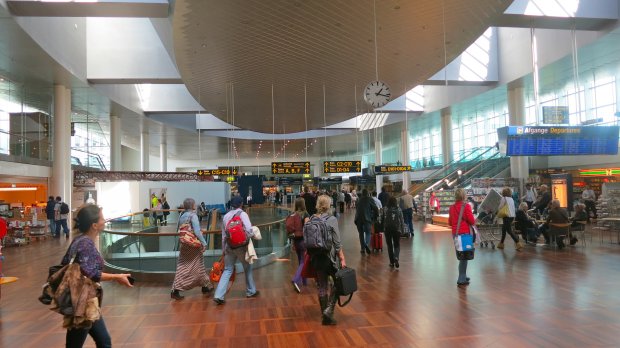Traffic Growth Supports Performance

Copenhagen Airports A/S (CPH) had a good start to 2015 with a 1.8% increase in passenger numbers.
Copenhagen Airports A/S (CPH) had a good start to 2015 with a 1.8% increase in passenger numbers. International traffic, and not least intercontinental traffic, were the drivers of the growth, and the non-aeronautical part of the business also continued to improve. CPH retains its profit forecast for the full year.
Copenhagen Airports A/S (CPH) had a good start to 2015 with a 1.8% increase in passenger numbers. International traffic, and not least intercontinental traffic, were the drivers of the growth, and the non-aeronautical part of the business also continued to improve. CPH retains its profit forecast for the full year.
Passenger numbers at Copenhagen Airport reached 5.4 million in Q1, equivalent to a growth rate of 1.8%, making Q1 the busiest first quarter in the airport's 90-year history. The increased number of passengers led to an increase in revenue by 4.8% to DKK 871.9 million and an increase in profit before tax of 12.9% to DKK 240.4 million.
The growth in passenger numbers was mainly due to the full-year effect of the many new routes opened in 2014. The growing number of intercontinental passengers was due to the introduction of new long-haul routes by Norwegian and a capacity increase on Qatar Airways' route to Doha.
Growing intercontinental traffic
“In our competition with other European hubs it is important for Copenhagen to be able to continue growing our intercontinental traffic. More overseas destinations served by Norwegian, additional weekly frequencies from Qatar and the announced introduction by Emirates of the A380 in December are important steps in realising our growth strategy," said Thomas Woldbye, CEO of Copenhagen Airports A/S.
Intercontinental traffic grew by 4.7%, while European traffic grew by 2.2% despite strikes at both SAS and Norwegian. On the other hand, the volume of traffic was positively affected by Ryanair's start-up of operations at Copenhagen. Domestic traffic was down by 6.7% due to a drop in capacity on a number of the domestic routes.
A high level of capital investment
Capital investments in Q1 2015 were higher than in Q1 2014. To accommodate the significant intercontinental growth, CPH is expanding the intercontinental Pier C and one of the runways. These projects are two of the initiatives that will prepare Copenhagen Airport for the Airbus A380.
Moreover, CPH will complete the renovation and expansion of Terminal 2 later this year. Also, the two additional lanes for security screening were opened recently.
Capital investment in Q1 also included the merger of Domestic and Schengen traffic and an expansion of the critical security restricted area (CSRA) connected to the terminals. These two projects are the result of the new charges agreement that came into effect on 1 April 2015, and both projects will lower the airlines' costs of operating at Copenhagen Airport, which is in line with CPH's strategic focus.
Strong shopping centre makes investment possible
Revenue at the shopping centre was up by 8.9%, and the spend per passenger was higher than in the same period of last year, driven by an improved shop and brand mix and the full-year effect of a number of new units.
Parking revenue grew by 6.3%, driven by higher online sales. Lastly, the hotel operation improved by 6.9%, primarily due to a very high occupancy rate at the Hotel Hilton Copenhagen Airport.
"In Q1, the non-aeronautical part of the business accounted for 44.4% of revenue, but 85.9% of EBIT. Thus, the non-aeronautical part of the business contributes to an increasing extent to the large capital investments we are making to develop and expand the airport," said Woldbye.
Lower external costs
In Q1, CPH reduced its external costs excluding one-off items by 4.5%, which was driven by ongoing efficiency improvements. Conversely, staff costs were up by 10.6%, partly because an additional 52 security staff were hired as a result of stricter regulatory requirements.
Outlook for 2015
The outlook for traffic growth, profit before tax and capital expenditure is unchanged from the announcement of 26 February 2015.
Based on the expected traffic programme for 2015, an increase in the total number of passengers is expected. However, unexpected fluctuations in the offering of routes or the general economy may affect developments and profit.
The growth in the number of passengers and the changed structure of charges as from 1 April 2015 is expected to have a positive impact on revenue.
Operating costs are expected to be higher than in 2014, primarily due to the expected rise in passenger numbers, stricter requirements to security, and cost inflation, but this will be partly offset by a continuing focus on operating cost efficiencies.
Overall, depreciation charges and financial costs are expected to be slightly higher in 2015 than in 2014, primarily as a result of the continually high investment level. Profit before tax for 2015 is expected to be in the range of DKK 1,300.0 million to DKK 1,400.0 million, excluding one-off items. Operating profit before depreciation is projected to be higher in 2015 than in 2014, excluding one-off items.
Forecast of capital investment
CPH expects to continue to invest for growth. As in recent years, CPH still expects to invest at a high level in 2015.
Planned investments include expansion of the critical security restricted area (CSRA) at the airport and the consolidation of the terminal areas, which is part of the charges agreement that comes into force on 1 April 2015. CPH will also be investing in non-aeronautical projects for the benefit of airlines and passengers.


